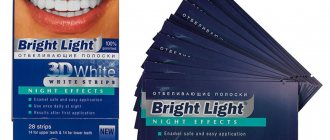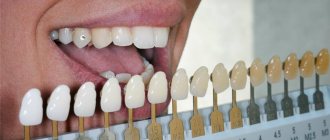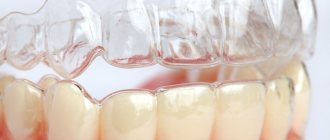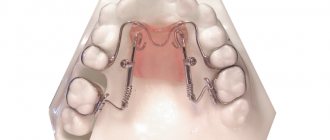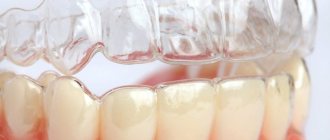The first mouth guards specifically for correcting malocclusion appeared in the last century. True, then they were created in stages - impressions were taken for the first aligner, after it was worn in - repeated impressions and the production of a second aligner, and so on. Today, the patient receives a ready-made set of aligners, the size of which is selected using modern computer equipment.
Indications
- spaces between teeth
- crowding and overlapping of teeth
- open and cross bite (with slight displacement of the jaws),
- changes in the position of the teeth - rotations, tilts.
Contraindications
- allergic reactions to aligner materials (extremely rare),
- severe violations of the position of the teeth,
- significant displacement of the jaw position,
- age up to 12 years.
What are braces and who are they for?
We have known about braces for quite a long time - both in life and in movies we have seen people with characteristic braces on their teeth. Essentially, braces consist of small clasps glued to the teeth with special dental glue, and a metal arch passing through them, connecting them into a single system.
The archwire transfers pressure to the teeth, which causes the misaligned teeth to gradually shift toward a more correct position. As the defects are corrected, the arch must be tightened: for this, the patient needs to visit the dentist once every 2 weeks, and after treatment is completed, he also needs to wear special retainers that will prevent the possibility of reverse displacement of the straightened teeth.
At the same time, there is another method - the use of aligners. What is the difference between braces and aligners? Aligners are transparent aligners made of special plastic that fit tightly onto the teeth and create the necessary pressure to correct misaligned teeth. Speaking about the difference between braces and aligners, it can be noted that braces create many inconveniences in everyday life: they are clearly visible from the outside, they must be thoroughly cleaned after every meal, they are difficult to get used to and serious dietary restrictions must be observed during the period. wearing them.
However, in case of serious malocclusion, it is necessary to wear braces. In addition, aligners are usually used only for adults who have completed their period of jaw growth, although aligners are now being developed for children over 7 years of age. Braces do not have such a limitation - they can be placed on children at almost any age.
In addition, there is a difference between braces and aligners in the force of impact: braces are a more rigid structure that puts more pressure on the teeth, so they can be used to correct more complex situations.
Advantages of braces systems
Braces are noticeable on the teeth when smiling and while talking, and this is one of their main disadvantages. They can cause inconvenience and a feeling of embarrassment and require adaptation and careful care. But their effectiveness easily covers these shortcomings. This technique has many advantages:
- braces are more rigid and exert strong pressure on the teeth, increasing the effectiveness of correction and accelerating the result;
- suitable for correcting dental anomalies in complex cases, where aligners are powerless;
- suitable for adults and children.
But even with their high effectiveness, the patient will have to visit the doctor repeatedly and on a regular basis, and treatment can last from several months to several years.
To minimize the aesthetic defect during treatment, you can use ceramic, sapphire or ligature braces, which are installed on the inside of the teeth. They are not so noticeable, but it is impossible to completely hide them. In addition, ligature systems may not be used in all clinical cases.
When wearing braces, you will have to comply with serious dietary restrictions. It is necessary to avoid or minimize the presence in the diet of foods that are too hard, hard and stick to the teeth.
Braces require more careful oral hygiene. The patient needs to brush not only his teeth, but also scrupulously clean all structural elements where food particles may become clogged. Otherwise, plaque will be deposited in hard-to-reach places and cause bad breath, the development of dental diseases, and caries.
An alternative to braces is aligners.
In many cases, aligners can be used instead of inconvenient braces. Their key feature is that it is a removable structure made of transparent plastic that fits tightly to the teeth. This option is indispensable for those who, for some reason, cannot allow their appearance to change, because braces are clearly visible when talking and smiling, and they will have to be worn for several months, sometimes even up to 2 years. Of course, there are braces that are less noticeable, made of polymer or ceramic materials, as well as lingual braces, which are placed not on the outside, but on the inside of the dentition, but they cannot always be used, and their cost is much higher than usual.
Aligners are an analogue of braces, since they use the same general principle - applying constant pressure to the teeth in order to move them in the desired direction. The only difference is in the design, and as a result, in some functions and properties. Firstly, they are transparent, which makes them very unnoticeable from the outside, and secondly, they can generally be removed during an important meeting or photo shoot. To achieve the desired effect, aligners must be worn 20-22 hours a day, so you can always find time for meals or negotiations to remove the aligners for a while.
The difference between aligners and braces includes several important points:
- aesthetic – unlike braces, they are not visible,
- mechanics of impact – more evenly distributes pressure on each tooth,
- removable - they can be removed, hence there are fewer restrictions on food intake and easier hygiene,
- allergenicity - are made of hypoallergenic plastic, and braces are made of metal.
An orthodontist will help you decide to use aligners or braces in case of dental alignment, based on the specific clinical situation, individual characteristics and requirements of the patient.
Stages of treatment
The aligners are made of soft silicone, they are very thin and fit tightly to the teeth. Aligners are developed strictly individually and only in the companies that develop these products. That is, preparation, approval of the plan, taking impressions and monitoring of the treatment are carried out directly in the clinic.
The patient is given a full set of aligners for the entire period of treatment (and its duration is usually about 9-12 months, less wearing braces). (the amount varies depending on the severity of the malocclusion). Each aligner has its own shape and has a specific effect on the teeth, causing them to move in the desired direction. If you use the system correctly, the first results will be noticeable within 3-4 months.
According to numerous studies, mouth guards have virtually no restrictions on their use. And with a competent approach, they allow you to solve problems of malocclusion of any complexity1.
How to wear aligners
Each mouthguard must be worn for about 2 weeks, strictly observing the date of replacement. The daily norm of wearing a mouthguard is at least 20 hours; the aligner must be removed while eating or performing hygiene procedures.
After removal, the aligner must be cleaned; after eating, be sure to brush your teeth and remove any remaining food from the interdental spaces. It is important to store the aligner in a special container that will protect the aligner from dust and external influences.
Pros and cons of aligners and braces in use
Comparing aligners and braces allows you to understand the question of which technology is best to choose in your case. Each technology has its own advantages and disadvantages, and for convenience we will summarize them in a table.
| Comparison options | Aligners | Braces |
| Appearance | Transparent aligners | Locks. glued to the teeth, and a metal arch connecting them |
| Color | Transparent | Any |
| Material | Polymer | Metal/Polymer/Ceramics |
| Allergenicity | No | Yes |
| Are they suitable for children? | No | Yes |
| 3D modeling of jaws on a computer | Yes | No |
| Discussion with the doctor of the result and patient participation in treatment | Yes | No |
| Preparation time | 7 days | 1-2 days |
| Installation time | 45-60 minutes | 3-6 hours |
| Taking impressions before installation | Oral scan + impressions | Yes |
| Treatment speed | 30% faster | Slower |
| Impact mechanics | Simultaneous rotation and displacement of the tooth in the desired direction due to tight coverage | Consecutive displacement in one direction or another and rotation |
| Risk of caries | No | Yes |
| Possibility of enamel remineralization | Yes | No |
| Possibility of injury to the mucous membrane | No | Yes |
| Frequency of visits to the doctor for correction | Every 4-6 weeks | Every 2 weeks |
| Dietary restrictions during treatment | Almost not | Yes |
| Possibility to remove the structure for eating or cleaning | Yes | No |
| Food getting stuck between teeth | No | Yes |
| Bad breath after eating | No | Yes |
| Difficulty in oral hygiene | No | Yes |
| The need to brush your teeth after every meal | No | Yes |
| The need to use dental floss and toothpicks | If necessary | Necessarily |
| Using a special toothbrush | No | Yes |
| Toothbrush lifespan | Standard | Short (due to increased wear) |
| Opportunity to see results before treatment begins | Yes | No |
| Need to be worn constantly | No | Yes |
| Psychological comfort and self-esteem | Yes | No |
| Aesthetics of appearance | High | Low |
| Feeling of discomfort | No | Yes |
| Possibility of pain at the beginning of treatment | No | Yes |
| Impaired diction | Almost not | Yes |
| Protecting teeth from injury | Yes | No |
| Ease of installation and wearing | Yes | No |
| Possibility of self-replacement | Yes | No |
| Possibility of peeling off | No | Yes |
| Disruption of the usual way of life and forms of communication | No | Yes |
As can be seen from the above comparison, aligners are more convenient in almost everything. Braces cause more discomfort, require changes in the usual lifestyle and diet, and, in fact, the only case when braces are preferable is when the patient is a child. Therefore, when choosing between braces or aligners, according to the orthodontist, it is better to prefer aligners.
Orthodontic treatment and basic devices
As you know, orthodontists are involved in identifying, eliminating and preventing dental anomalies. In their opinion, regardless of the patient’s age, there is always the opportunity to move the tooth to the right place, as well as to stimulate or inhibit the development of the bone structures on which the teeth are attached. This is due to the compliance of the supporting-retaining apparatus.
There are several ways to perform orthodontic treatment, namely:
- Conservative therapy. It consists of using special devices: braces, transparent aligners, thin overlays on teeth, etc.;
- Surgical intervention. This method is used in difficult situations when it is not possible to eliminate the defect using orthodontic appliances. However, a prerequisite after surgery is the use of braces or transparent aligners.
To understand what is better to choose after surgery - aligners or braces - you should pay attention to the following criteria.
Advantages of aligners over braces
The two main advantages - aesthetics and wearing comfort - are due to the design of this product. This allows you not to experience embarrassment during treatment, as happens when wearing braces, when a person is embarrassed to smile and talk, experiencing stress and becoming withdrawn, refusing to communicate. Aligners eliminate such problems - they make you look the same as usual, and in extreme cases they can be removed altogether.
Aligners are more effective than braces in another respect: there are almost no restrictions on food intake. Even solid foods can be eaten if they are removed before meals. It is impossible to remove the braces for a while, so you will have to eat in them, which means you will have to give up solid food, which can break the structure, and after eating, rinse your mouth thoroughly and brush your teeth using special brushes and toothpicks, since food gets stuck between them much more strongly. teeth.
Well, difficulties in oral hygiene will result in the development of caries if the patient allows himself to relax and not be too diligent in caring for the oral cavity. When using aligners, such problems do not arise, you can eat and brush your teeth as usual.
Finally, what makes you choose aligners instead of braces is their purely medical effectiveness - treatment with aligners is faster, and you can change the aligners yourself if necessary. Aligners cover the teeth more tightly and transfer the load to them more evenly, allowing them to be moved in several axes at once, which speeds up treatment and at the same time makes it safer and more comfortable.
Indications and prohibitions for occlusion correction using aligners
What defects are treated with mouth guards:
- tilting or turning of teeth;
- non-critical pathologies of occlusion;
- crowded arrangement of dental elements or, on the contrary, large gaps between them.
Contraindications for installation:
- periodontal disease in the acute phase;
- mental illness;
- the presence of impacted (formed, but not erupted) dental units;
- jaw anomalies.
Indications and contraindications are identified by the dentist at a consultation after visual and hardware diagnostics. Our dental centers are equipped with all the necessary equipment to perform diagnostic and therapeutic procedures.
What is more expensive - braces or aligners?
In some individual cases, expensive branded aligners may be more expensive than cheap braces, especially with long-term treatment involving many stages. But if the comparison is made correctly, comparing cases of the same degree of complexity, then the difference in the price of braces or aligners will either be minimal, or even aligners will be more profitable.
Imported mouthguards from foreign manufacturers are more expensive. Our clinic cooperates with Star Smile, a leading domestic manufacturer of aligners, which, with completely similar quality, have a much lower price. This allows us to offer treatment for malocclusion using aligners at the most affordable prices.
Therefore, to the question: what to choose: braces or aligners? – our doctors answer unequivocally – choose aligners. This will provide greater comfort during treatment, better aesthetics and will be much more profitable.
What result can you expect
Today, only some, the most severe, malocclusions cannot be corrected with aligners. Typically, these are situations where jaw surgery is required. In this case, the doctor may recommend permanent braces (before or after surgery), and sometimes an orthodontic facial mask is required.
But most disorders are classified as mild or moderate, and all of them are corrected with the help of removable mouthguards.
The doctor always develops a treatment plan so that the result is ideal: straight teeth and their correct closure. Moreover, if there are impacted teeth, they try to preserve them, that is, bring them to the correct position, and not remove them.
With aligners, you can count on the fact that your bite will be perfect: both the position of the teeth and the closure of their rows will be absolutely correct. Typically, the orthodontist does not stop treatment until this result is achieved.
Popular aligner manufacturers
Aligners are a relatively new invention in dentistry. They began to be actively used in the early 2000s. Initially, they were produced only by an American company, but then other countries began to produce high-quality aligners.
At the moment, the most popular manufacturers of aligners are:
- Star Smile. The price of these mouthguards is not that high since they do not have to be shipped from the USA. The aligners are manufactured in Moscow, but using American technology. The mouthguards are also changed every 2 weeks, the course of treatment is up to 15 months.
- Orthosnap. One of the cheapest aligners. Computer modeling is not used in their manufacture, so it is difficult to judge their effectiveness.
- Clear Correct. These mouth guards are suitable even for those who have very sensitive gums and have a reaction to synthetic materials. They are made in the USA.
- Invisalign. Invisalign appeared on the Russian market earlier than other aligners. Therefore, many dentists prefer to trust this brand. These aligners are usually changed every 2 weeks. They are highly effective, but the price is also quite high.
It is worth clarifying that in the clinic the doctor only takes pictures and modeling. The aligners themselves are manufactured in the country where the manufacturer is located.
Rules for wearing and care
Successful correction of occlusion is impossible without careful adherence to the orthodontist’s recommendations. Our dental center specialists advise:
- wear mouth guards daily for 22 hours;
- remove orthodontic products before eating or drinking hot drinks;
- brush or rinse the aligners with running water before each use;
- To clean the trays, use special pharmaceutical disinfectants or (if slightly dirty) a soft brush and paste. Note: Products cannot be boiled or washed with hot water;
- Use special containers for storage.
As you can see, the rules are simple and easy to follow.
Effective models
In their practice, specialists from our network of clinics use orthodontic aligners that meet the following requirements:
- high impact efficiency;
- harmlessness to human health;
- Positive assessment from patients and orthodontists
Many types of aligners meet these requirements, but the following models are especially popular:
- Invisaling (USA) - made to individual sizes from thin polymer, practically invisible to a prying eye. The advantage is that it can be used from the age of 8;
- FlexiLigner - effective in difficult cases: open and cross bites, dystopia (deviation from the correct growth vector), rotation (rotation).
- KidsLight - this line is a modification of the FlexiLiner brand for children over 5 years old.
Features of installing aligners
Aligners as an orthodontic structure, unlike braces more familiar to most people, are removable. Mouth guards must be removed when eating or performing hygiene procedures. Aligners are made of soft transparent material, so they are almost invisible on the teeth.
Aligners are put on the entire dentition (separately the upper arch and lower arch). The mouthguards follow the anatomical shape of the teeth, fitting tightly to them. Currently, transparent aligners, as orthodontic corrective structures, are the most aesthetic and comfortable in treatment.
We make aligners individually for each patient. To do this, the doctor first collects the patient’s diagnostic data (photos, x-rays, impressions or 3D scans of the dentition), then a detailed treatment plan is drawn up, and all information is electronically sent to the Flexiliner laboratory.
Other features of the manufacture and installation of aligners include the following factors:
- Exact repetition of the physiological shape of each individual tooth.
- High aesthetic component. The mouthguards are invisible even close up.
- There is no risk of damage to the mucous membranes of the oral cavity. This is due to the fact that the mouth guards do not have hard parts and are made of soft elastic material. They do not scratch or rub either the gums or the inner surfaces of the cheeks.
- There is no discomfort when talking.
- FlexiLigner aligners can correct almost any disorder of the dental system.
Before starting treatment, the patient goes through a preparatory stage. Caries treatment is carried out, teeth are cleaned from stone and plaque, inflammatory processes and other problems are eliminated. The subsequent algorithm of actions looks like this:
- The doctor makes impressions of both jaws of the patient. He is also sent for a computed tomography or orthopantomogram, which provide more detailed information about the condition of the bone tissue. It is subsequently sent to the FlexiLigner laboratory.
- Mouth guards are created using modern 3D modeling programs. With their help, specialists work out a plan for correcting dentition down to the smallest detail and predict the results.
- On average, it takes at least 2 weeks to produce a set of aligners, as this is a multi-stage process from diagnostics to prototyping (3D printing).
- When a set of aligners falls into the hands of an orthodontist, the doctor installs the first set in the patient’s mouth and explains how the treatment will proceed and the wearing rules. The doctor gives recommendations that must be followed to achieve the desired treatment result. The success of the correction and the time spent on it depend on their compliance.
The process of making aligners is computerized as much as possible. As a result, the risks of errors and any inaccuracies are minimized, and the method is incredibly effective.
Operating principle of the devices
For one course of corrective therapy, several copies of trays are made, each of which differs in minor changes in the positioning of dental units. The number of sets (from 10 to 40) and the step of geometric parameters are calculated on a computer using special software, which calculates distances and angles of movement with perfect accuracy.
The essence of corrective therapy with aligners is to create constant soft physical pressure, which forces the dental elements to move in a given direction. The bone tissue dissolves in the direction of the impact, the teeth move a little, and where they were before, new bone tissue is formed.
As intermediate stages are completed, the patient himself changes the aligners in strict accordance with the numbering of the copies.


